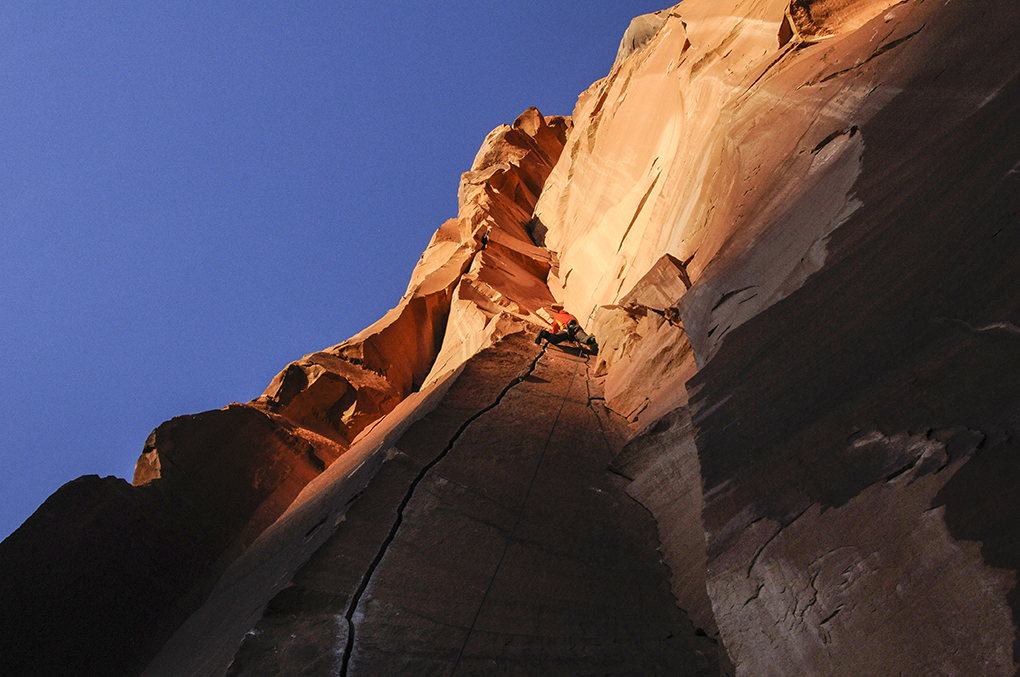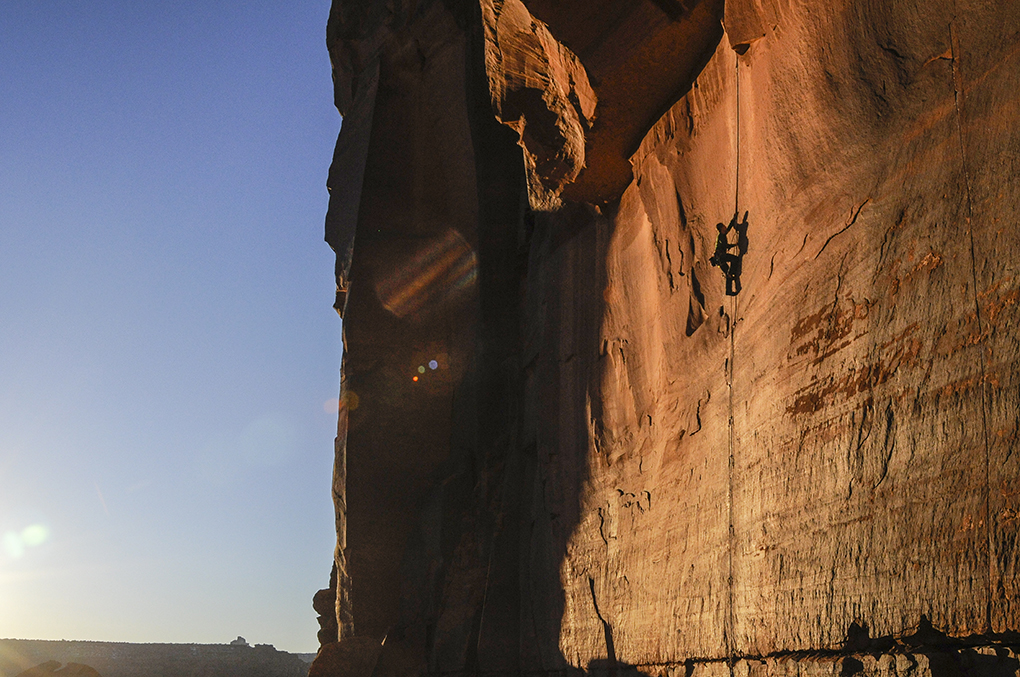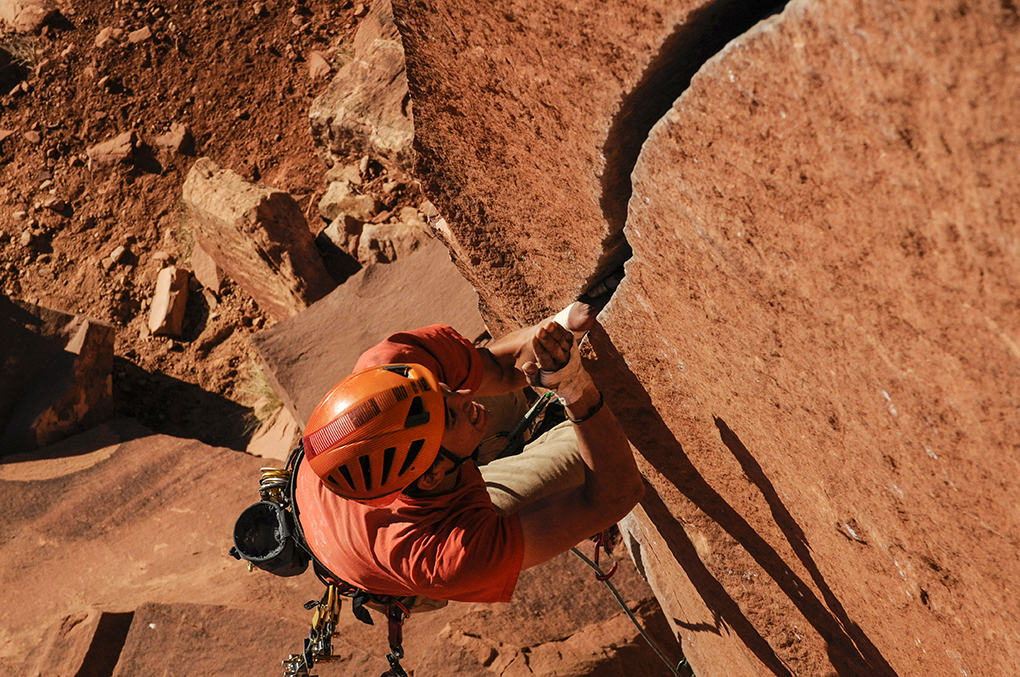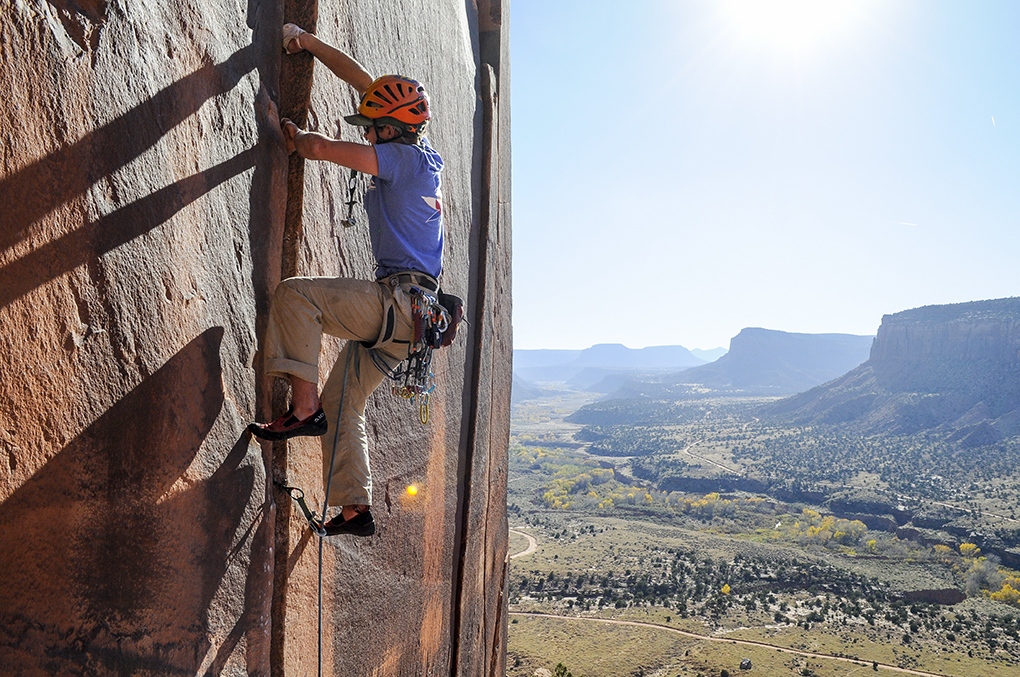Climbing!
This is what you came for, right? There is nowhere else in the world that features a greater concentration of splitter cracks than Indian Creek. There’s a reason why on any given day in the fall you’ll hear three or four different languages at the crag.
Most of the crags at the Creek face south and receive incredible sun exposure, though the number of corners and dihedrals make finding shade possible nearly anywhere, even on the sunniest of days.
Chasing last light on Scarface Wall (5.11-), Indian Creek. This is a classic. (photo by Matt Zia)
The definitive guidebook is Indian Creek: A Climbing Guidebook (Camalot Edition) by David Bloom. Make sure you put your name on it, because there’s sure to be a dozen copies at the crag and campfire.
Bloom’s guide is very thorough, but by no means complete. The sheer amount of rock at the Creek means new routes are going up all the time, and old routes are getting updated. Use the guidebook as an amazing resource, and be prepared to make your own decisions about the necessary rack for a given climb. One night around the fire this fall we counted the number of distinct areas in the guidebook and got 47 total, some with five established routes, and some with nearly two hundred. One small piece of Creek lore: many walls are named after the most classic route on them. Hence, Supercrack Buttress, Battle of the Bulge, Scarface Wall, and Way Rambo. If you’re looking for a classic, climb the wall’s namesake. Although generally on the harder side, the namesake routes range in difficulty from 5.10 to 5.13.
Run Like Hell (5.10) at The Wall, Indian Creek. It’s directly adjacent to Wish You Were Here. (photo by Matt Zia)
Incisor (5.11) at Broken Tooth Wall, Indian Creek. (photo by Matt Zia)
Make sure your rack is labelled well, too. Nail polish or tape works best, just make sure to mark your gear in a place where it won’t wear off. Remember your friend’s rack they lent you? Know what’s on it and how it’s marked too, so you don’t lose their cams.
And tape. Lots of tape. I could write pages on different ways to make tape gloves, but however you choose to do it, taping up will save your hands and prolong your trip. My tape of choice is Eurotape, but any type of cloth athletic tape will work well. Just make sure to pack out your tape trash at the end of the day.
During the fall, weekends can be absurdly busy, so be courteous to other climbers, don’t hog the classics all day, and share the stoke with everyone.
Johnny Cat (5.11+), Cat Wall, Indian Creek. (photo by Matt Zia)
Matt on Scarface (5.11-). A tricky start leads into nearly 80 feet of perfect hand crack. (photo by Hannah Trim)
Rest Days
The climbing at the Creek is perhaps the most consistently physical climbing in the US with few rests, unrelenting jamming, and few routes less than 100 feet long. I’ve long been a fan of a schedule of approximately 3-4 days on and then 1-2 rest days. The most obvious rest day activity is to drive up to Moab to restock on groceries, water, check email, and try to find a shower, but that’s only one option. Others include but aren’t limited to:
Going to the crag with your friends and alternating between napping the sun or shade, heckling them into trying harder, and taking butt shot photos of them.
Wandering down one of the many side canyons on an adventure hike, Donnelly Canyon is an excellent option, but don’t get distracted by the endless unclimbed splitters, it’s a rest day remember!
Sitting around camp reading philosophy books and contemplating our place in the universe (guilty as charged… )
Liberally apply hand salve to all the gobies on your hands you’ve developed from jamming. My two favorites are Joshua Tree Healing Salve and Climb On! lotion bars. In reality, this should be an every night activity.
Coyne Crack Simulator (5.11-) at Pistol Whipped Wall, Indian Creek. (photo by Matt Zia)
Responsibility
The desert is one of the most fragile ecosystems on Earth, and Indian Creek is no exception. Before you go, remember these few things:
Tip-toe around the crypto! Cryptobiotic soil is the fragile crust that holds the surface of the desert together. A single step will destroy the crust though, exposing the sand below to erosion, and crypto takes hundreds of years to regrow. Stay on the trail and don’t crush the crypto.
Pack it in, pack it out. Goes for trash, tape gloves, and especially human waste. Time your bathroom visits to when you’re near a pit toilet, and bring a WAG bag for those times you absolutely can’t hold it.
Respect Dugout Ranch. A fair amount of the land in Indian Creek Canyon is owned by the Nature Conservancy and operated as a ranch by Heidi Redd. The ranch has the right to close off access, which has happened in the past due to rude encounters with climbers. When in doubt, be polite, control your dog, and leave the cattle gate as you found it.
DO NOT CLIMB AFTER IT RAINS! Sandstone is not granite, and requires more time to fully dry out. When sandstone is wet, the chemical bonds holding the grains together are significantly weaker than when dry (multiple peer-reviewed scientific studies have proven this). Many classic climbs at the Creek have widened over the years and feature blown out pods where cams have pulled from wet stone. For both your safety and the preservation of the rock, wait. I outlined plenty of excellent rest day activities above. Partake in one of those.






